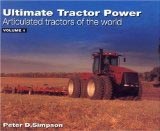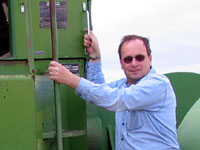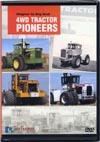Big Tractor Author Peter Simpson
Peter Easterlund/TractorData -Author and photographer Peter D. Simpson has created the most exhaustive volumes on large articulated four-wheel drive tractors. The Ultimate Tractor Power series of books covers dozens of manufacturers, both large and small. A four-volume video set produced by Mr. Simpson chronicles the history of large tractor manufacturers in North America. TractorData recently had the opportunity to talk with Mr. Simpson about his work.
TractorData: You have been employed as a tractor driver on English farms. Did you grow up on a farm? Do you recall the first tractor you drove?
Simpson: I was a bit of a rebel at school, my three brothers enjoyed lessons and learning while I enjoyed gazing out of the window and just wanted to be outside. The one thing I learned and enjoyed at school was horse riding on Wednesday afternoons. While everyone was playing football, six of us would go horse riding at a local farm, that was scary but fun, and on weekends I would help out on the farm.
By the time I was 14 I had been offered a weekend job on the farm, driving tractors and getting paid for the privilege, what more could a teenager ask for. That was more than 40 years ago when one of the most modern tractors on English farms was the little grey Fergie the Ferguson TE-20.
The farm had three tractors, a 20hp gas/kerosene Ferguson TEA-20, a 26hp diesel Ferguson TEF-20 and a brand new 35hp Massey Ferguson 35. The boss would drive the MF 35, but the other two tractors were mine to drive and look after, and that is how my life with tractors started.
 TractorData: Large four-wheel drive tractors are somewhat rare in England. Did you have a particular interest in 4WD tractors before you started the Ultimate Tractor books?
TractorData: Large four-wheel drive tractors are somewhat rare in England. Did you have a particular interest in 4WD tractors before you started the Ultimate Tractor books?
 Simpson: For 30 years I was quite content being a tractor driver, progressing to large arable farms where we grew all types of crops from wheat, barley, peas, beans, linseed, potatoes and many other crops, for the intensive farms in the UK FWD tractors in the region of 100hp were the norm. 4WD tractors were very rare, there was the British built MF 1200 and 1250 and a few Steiger built Ford FW-30 and 60's had been imported but they were mainly in the west of England where the land was heavy and big farms common.
Simpson: For 30 years I was quite content being a tractor driver, progressing to large arable farms where we grew all types of crops from wheat, barley, peas, beans, linseed, potatoes and many other crops, for the intensive farms in the UK FWD tractors in the region of 100hp were the norm. 4WD tractors were very rare, there was the British built MF 1200 and 1250 and a few Steiger built Ford FW-30 and 60's had been imported but they were mainly in the west of England where the land was heavy and big farms common.
In the meantime, to supplement my low farm wage I took up a hobby and that was photography, I started supplying a horse racing magazine with illustrated articles and then went on to write for a new magazine called Tractor & Machinery which has become the world's top selling enthusiast tractor magazine. Looking back, that was some 15 years or more ago.
TractorData: Writing for a magazine and working on the farm must have been busy work, but what made you write Ultimate Tractor Power?
Simpson: When writing for magazines I discovered two very important factors, one was to supply quality photographs and the second was to include accurate facts so when a reader read the magazine they would learn something new. Japonica Press knew how I undertook in-depth research and in 1998 the publisher asked if I would write a book for them on big 4WD tractors. I must admit I knew nothing about the big American tractors what so ever, but up for a challenge I said yes, then the hard work started.
One book became two as I found more 4WD tractors around the world, the countries where tractors were built included America, Canada, Brazil, Europe, Africa, Australia, France, Germany, Russia the UK and many more, I think at that time no one including myself knew how many different makes of 4WD tractors there were.
TractorData: How did you research all these machines as a book specifically on 4WD tractors had not been written before?
Simpson: It seems like the internet and the world wide web along with google have been available for a lifetime. Surprisingly when I actually started writing the books in 1999 www. and google were in their infancy and hardly any tractor info at all could be found on the web. Most of my research was undertaken by writing letters and making telephone calls around the world. Quality images could not be sent by e-mail. I can clearly remember driving a combine harvester until 10.00 at night, come home, have a shower and eat a meal, then sit at the computer for a few hours and making telephone calls to Australia at 2.00 in the morning. Today there is so much available on the world wide web, sourcing information has become so much easier in a very short space of time.
The whole 4WD subject became a bug, something started which could not be put down. I kept finding different 4WD tractors and as people globally found out what I was doing they would either telephone or write telling me of more tractors in the end I included over 52 different makes of articulated four-wheel drive agricultural tractors.
One must not forget that researching and writing the two books was not an easy matter, I had a young family, worked on the farm and by the time the second book was published, more than three years had passed, but I enjoyed every minute of the work.
Prior to and by the time Ultimate Tractor Power volumes 1 & 2 were printed no one else had ever undertaken such a massive in depth project on the subject and despite there being one or two omissions which I have since found and along with a couple of small mistakes these two books are still the definitive works on 4WDs.
TractorData: Automation and satellite navigation systems are bringing an increasing level of automation to farm operations. In particular, to the large-scale planting, tillage, and harvesting work associated with large four-wheel tractor tractors. We are not far from the possibility of having no driver in the tractor seat. While there are great benefits to precision operations, do you have any thoughts on the loss of the hands-on machinery operations that dominated farm work for almost a century?
Simpson: This is a very big question to answer and one that would take more space than we have here. However there is one thing for sure.
I think I tackled the 4WD subject at the right time. Driving across the great wheat belts of America and Canada today you do not see the same amount of 4WDs you would have done even five years ago. With the advent and acceptance of minimum and lo-till seeding operations, chem fallow and modern technology coupled to the loss of mechanical summer fallow and extensive tillage operations of the past, many tractors and tractor driving jobs have disappeared. Also with the introduction of high-tech air seeders and sprayers, the use of GPS and the greater requirement for hydraulic services on a tractor for the new wave of associated equipment, older tractors can no longer cope and sadly they have been either parked up or broken up for spares and scrap.
Today the big subject is tractor engine emissions and again sadly older tractors cannot compete and have been decommissioned.
If I was asked me to write Ultimate Tractor Power today I am not sure if I could have found so many of the earlier tractors to photograph. Many of the great names have been swallowed up and today there are literally only a handful of 4WD tractor manufacturers still in production.
 TractorData: Do you have any next projects planned?
TractorData: Do you have any next projects planned?
Simpson: I have produced nine DVDs on big 4WD tractors around the world, I need to produce one more to make the work complete and that will be a DVD on Versatile. I have also written three books on 4WDs and I want to produce a further two, one is written and waiting to be printed, the other is in the planning stages - so watch this space.
For more than 10 years big 4WD tractors have dominated my life and I think by the time I have 10 DVDs and five books on the subject completed then I feel it will be time to call it a day, but who knows, there are many more possibilities on the subject ask me the same question next year and see if the answer is any different.
Selected works by Peter Simpson:
| Books: | Ultimate Tractor Power |
| Videos: | Wagner to Big Bud |
| Steiger, Part 1 | |
| Steiger, Part 2 | |
| New Century, New Power |
